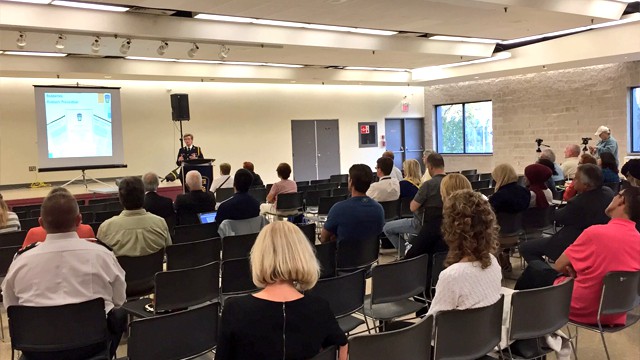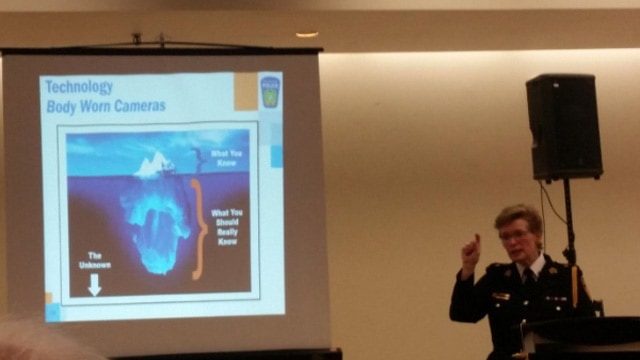“No Body Cameras” One of the Topics Discussed at Peel Police Meeting in Mississauga
Published September 19, 2016 at 3:09 pm

On September 15, the Peel Regional Police (PRP) held a sparsely attended public meeting at the Mississauga Valley Community Centre to outline information about the PRP’s latest initiatives, developments and statistics and to answer some questions from the public. There was a lot to take in, so I’ll break down what I observed in these following areas.
 Jennifer Evans – Public Relations Expert:
Jennifer Evans – Public Relations Expert:
Chief Evans was appointed to her current post in 2012. Before that, she had been a police officer since 1983, starting as a cadet. But I can’t help but wonder if the timing was not almost perfect in some ways; because if there is something that police forces need these days, it’s good public relations management. Unlike her verbally challenged counterpart from Toronto Police Service, Chief Mark Saunders, Chief Evans is a masterful communicator. From the way I observed Chief Evans conducted her presentation, outlining the data given and answering questions (for those who decided to get up and say something), she’s really good at, if not answering, alleviating people’s concerns.
Chief Jennifer Evans and Peel Police Board Chair Amrik Ahluwalia at Mississauga Peel Police public meeting. Ahluwalia got up to respond further on some questions Evans received about street checks.
Another reason I say that Chief Evans has really got the public relations thing down pat is she’s showing people that she and the police board are working. She’s presenting a united front to suggest that despite recent events pertaining to the police and the board, the two are working on the same page. In terms of the board, Chair Amrik Ahluwalia, Norma Nicholson, Jack Prazeres and Mayor Bonnie Crombie (who sits on the Police Board) were also present. To be fair, these people deal with issues of public safety in Peel Region; it makes no sense for any of them to be playing political games for real just to make a point. That would make everyone look bad. But given the recent disagreements between these particular board members and the chief over the issue of street checks/carding, as well as some of Chief Evans’ senior officers calling for the board chair to resign, it was a good move on her part to show that they’re still working professionally with one another and for the greater good.
 Speaking of “Street Checks” (aka Carding)
Speaking of “Street Checks” (aka Carding)
The question and answer session was structured so that questions were submitted in writing during a 10-minute recess after Chief Evans finished her formal presentation. I was curious as to why they didn’t just set up a microphone in the middle and allow the public to come forward with questions. In the end, that didn’t really matter; there were plenty of questions about everyone’s favourite subject: carding (known as street checks) and a decent little nugget thrown in about concerns over racial profiling.
Last month, a Toronto Star article revealed that the PRP conducted 159,303 ‘street checks’ (carding incidents) between 2009 to 2014. That means one in every 46 people. By contrast, the Toronto police recorded around 11,000 carding incidents, which meant one out of every 232 people. People always assumed with all the media coverage, Toronto had more problems with carding than Peel, but these statistics debunked that idea.
So someone actually submitted a question in writing on these very statistics, but Chief Evans’ answer was to say without actual numbers in front of her she couldn’t really comment on those comparisons. Board member Norma Nicholson did expand on the topic. She said the presence of Pearson International Airport it explains the higher Peel numbers. Peel Region is responsible for law enforcement at the airport so police officers assigned to patrol the airport are there to deal with illegal scoopers (taxis picking up fares at the airport who aren’t supposed to). Also people coming into the country are counted as being part of street checks. But still, I find it hard to believe that she didn’t know about the contents of this article since it came out almost a month ago. Ironic with all the stats in her presentation, Chief Evans omitted to mention this one.
There was another question about systemic racism in Peel, as a man wondered how often “driving while black” happens in Peel. Evans answered that she hoped that wasn’t happening; and that a website “Know Your Rights” was set up by Peel Regional Police to educate the public. There was also a question about ANPR, a license plate recognition software in the US, and whether that was being introduced. Evans didn’t really know about the American model, but she knew of a system in the UK that read license plates. One of her officers answered that the force has one car that automatically reads license plates, so maybe the PRP needs to cough up some money to buy more.
“Do you believe the end of carding has somehow lead to an increase in crime?” was one of the final questions I heard from the meeting. Chief Evans couldn’t say. Apparently as of April 20, Peel Region police officers are no longer submitting carding forms. She really emphasized that the practice of carding ended as of that date, but because the way the media has reported the issue, it seems carding is still being used by the police. At this point, the ball has really been kicked to the provincial government, who introduced new legislation back in March.
 Why No Body Cameras?
Why No Body Cameras?

Chief Evans goes on to a slide about body cameras, always a popular topic for those who are advocating for police reform. As to why there aren’t any for PRP, she basically cited increased administrative functions and issues regarding where authority over disclosure of private information lies (the police or the Crown) as reasons why PRP aren’t there yet. Another reason was the cost to taxpayers; at that point Chief Evans conveniently brought up that she’s going to present her budget to the Police Services Board next week.
But her iceberg analogy was somewhat confusing. It sounded like she was paraphrasing former United States Secretary of Defense Donald Rumsfeld, who during the Iraq invasion said ‘there were known knowns, and then there were known unknowns, but there are also unknown unknowns-the ones we don’t know we don’t know.’ So apparently if there were body cameras, people would be able to see a bunch of stuff that we really shouldn’t see? Isn’t that the point of accountability; that we want to see what exactly happened in any incident before passing judgement?
 A Plethora of Statistics:
A Plethora of Statistics:
I mentioned beforehand that Chief Evans’ presentation contained a whole bunch of statistics. They covered the period for this year from January to July, unless otherwise disclosed. Here were some of the numbers presented:
-
There are over 800 civilian/support staff working for the PRP.
-
Police Workload – there were over 183,000 calls to 911. Over 267,000 events recorded by Communications (48% citizen initiated, 30% administration, 22% officer initiated).
-
Workload Trends: Domestic Disputes, Assaults, Request For Assistance – Mentally Ill, and B&E Residence (these have all gone UP)
-
Fail to Stop/Remain, Drugs, B&E Businesses, MVC Property Damage (these have all gone DOWN)
-
123% increase in rounds fired (2015-16). 187% increase in shooting victims (Just people being at the wrong place at the wrong time, the Chief said)
-
Frauds are up (in 2016 over 900 fraud occurrences) – average of 4 per day. One such example are those CRA scam callers.
-
ROBBERIES – 443 in total. 240 robberies with weapons (up 31%) 203 robberies without weapons (up 15%)
Don’t bother looking up these statistics online though; you’ll most likely have to file a Freedom of Information request in order to see for yourself whether this is all completely accurate.
 Public Engagement Seemingly Lacking
Public Engagement Seemingly Lacking
One thing police do when they not on duty is volunteer, and the presentation did show the number of non profit events that PRP are involved in. In fact, on September 24 at Mississauga Celebration Square, in partnership with the Mississauga Chinese Business Association, the PRP are having a Community Crime Awareness Day with various sponsors and booths demonstrating various safety measures members of the public can undertake in order to prevent crime and be more vigilant.
It’s easier to attract people with a very large event and offer a whole bunch of stuff for the children to enjoy while also educating them about how to deal with various situations in your city (full disclosure, I’m a member of the Chinese Business Association and I have volunteered at this event in the past). It seems much harder to get them to come to a public meeting where serious questions can be asked. One middle-aged condo dweller from the Valleys neighbourhood mentioned that he told at least 300 people in his building about this meeting and only three of them showed up. He thought the lack of public engagement was disgusting and I couldn’t agree more.
So in conclusion, my takeaways from Chief Evans’ PRP public meeting are as follows:
-
She’s really good at public relations, making sure things get tampered down if they become really controversial.
-
She seems to be leveraging the “it’s gonna cost you” card when it comes to body cameras on police officers. It just so happens the people who control the purse strings, members of the Police Board, were present during this part.
-
Carding is not going away as an issue, despite the fact that police have actually stopped carding. No indication that the chief has changed her mind; I think she still wants to be able to utilize carding in some form or another.
-
The statistics were interesting, but I don’t expect people to be freely able to access them online or anywhere else, unless they file a Freedom of Information request. And those things take awhile.
-
Is there a lack of public engagement on policing issues? From this meeting (there weren’t that many people there at all), it looked like it.
Follow me on Twitter at @thekantastic
INsauga's Editorial Standards and Policies


